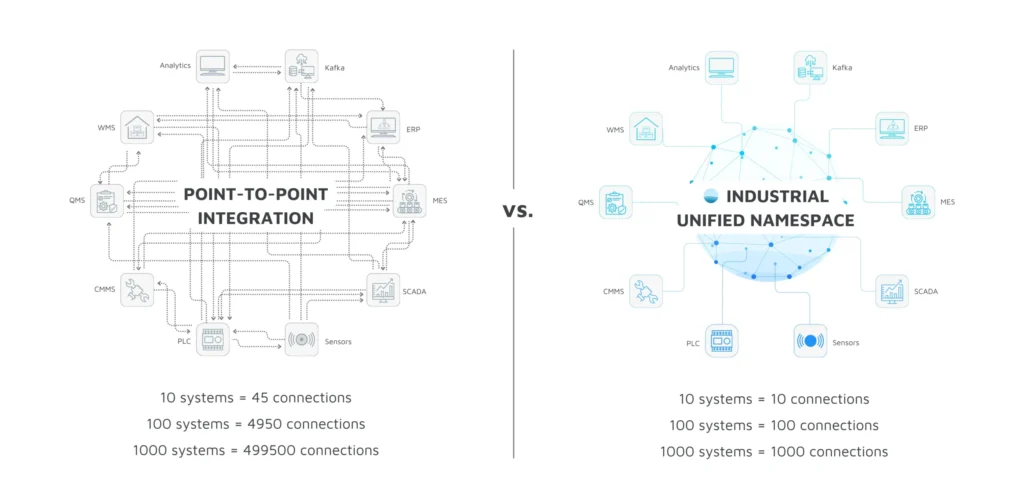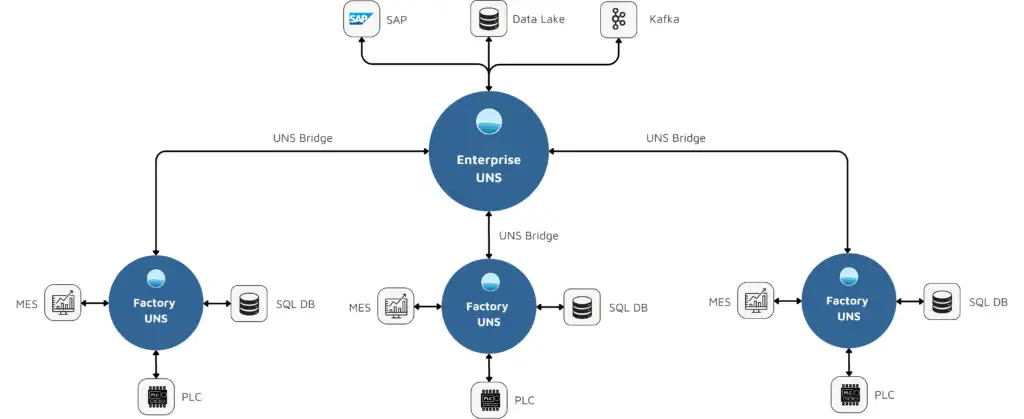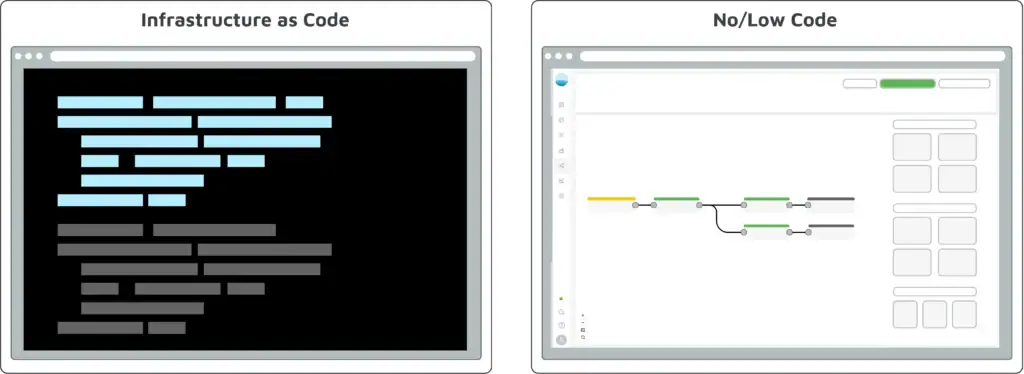In modern Industry 4.0 environments, companies must integrate data from diverse OT and IT systems and make it usable across the enterprise. A Unified Namespace (UNS) architecture addresses this by creating a central data space where all factory data converges. This namespace acts as the single source of truth for every system. Instead of duplicating data across multiple platforms, all stakeholders work with the same consistent dataset. For this approach to function reliably, clear design principles are essential. They define how systems are decoupled, how data is harmonized, and how security is enforced. This article outlines the key design principles of the Unified Namespace (UNS) architecture and explains how they enable a scalable, robust, and future-proof industrial data infrastructure.
1. Design Principle: Publish Once, Distribute Everywhere
In a Unified Namespace (UNS), all OT and IT systems communicate loosely coupled rather than through direct point-to-point connections.
Technical background: Data sources publish their information once into the namespace (publish once). From there, any number of consumers can subscribe to this data (distribute everywhere). Instead of creating rigid dependencies between systems, communication flows through the central data space using protocols such as MQTT.
Design implications:
- Lower integration effort: New machines or applications only need to connect to the namespace, not to multiple existing interfaces.
- Reduced load on networks and devices: Data is published once and distributed to all consumers. This minimizes communication overhead, especially for resource-constrained devices such as PLCs.
- Increased flexibility: The UNS acts as a decoupled integration layer, allowing systems to be updated, replaced, or scaled independently without impacting others.
2. Design Principle: Distributed Architecture
Contrary to a common misconception, a Unified Namespace (UNS) is not a single, centralized broker. Instead, it follows a distributed architecture with multiple local UNS instances deployed at the edge in plants, production lines, or even machine cells.
Technical background: Each local UNS instance may run its own MQTT broker or comparable communication component. It delivers context-rich data to local applications and continues operating autonomously if network connections are interrupted. When required, selected data is forwarded from local instances to higher-level or central UNS instances — such as at plant, enterprise, or cloud level. This synchronization is performed selectively and rule-based, using mechanisms like MQTT bridging or configurable forwarding rules.
Design implications:
- Local autonomy and performance: Edge instances operate independently, ensuring low-latency applications remain functional even during network outages.
- Global data availability: Central UNS instances consolidate selected datasets across plants and sites for enterprise-wide visibility.
- Scalability: New sites, lines, or machines can be integrated simply by adding local UNS instances without redesigning the entire system.
3. Design Principle: Report-by-Exception
In a Unified Namespace (UNS), data flows should follow the report-by-exception principle: information is published only when a value changes state or a defined event occurs.
Technical background: Report-by-Exception is a proven method in automation technology to prevent unnecessary data transmission. Unlike cyclical polling — where data is sent at fixed intervals regardless of changes — this approach reduces network and system load significantly. Data points generate messages only when new information is available. Push-based protocols such as MQTT natively support this pattern by immediately distributing state changes to all subscribers. For legacy systems without event-driven capabilities, polling can be used as a fallback, but it should be minimized.
Design implications:
- Efficient resource usage: Bandwidth and CPU load remain low, since only relevant changes are transmitted.
- Reduced latency: State changes are delivered in real time, without waiting for the next polling interval.
- Legacy compatibility: Polling can still be applied to non-event-capable systems, but is limited to these cases.
4. Design Principle: Modularity
A core design principle of the Unified Namespace (UNS) architecture is its division into clearly separated modules, each serving a specific function.
Technical background: This functional separation allows independent deployment, scaling, and optimization of each layer. Changes or failures in one component do not directly impact others, which increases the robustness and adaptability of the overall architecture. A modular UNS typically consists of the following layers (find more details here):
- Connectivity – Integration of diverse data sources and IT/OT protocols
- Harmonization – Semantic normalization, data modeling, and structuring based on common standards.
- Single Source of Truth – Local and central namespaces for distributing all data streams in real time.
- Microservices – Encapsulated logic for processing, aggregation, and analytics of UNS data.
- Management and security – Centralized monitoring, configuration management, access control, and security policies.
Design implications:
- Improved maintainability: Errors or updates remain isolated to the affected layer.
- Greater flexibility: Modules can be replaced or modernized without impacting the overall system.
- Targeted optimization: Each layer can be scaled and fine-tuned independently.
5. Design Principle: Central Governance
A distributed UNS architecture requires centralized governance to ensure consistent operation and security across decentralized environments.
Technical background: Through a central user interface or API, connectors, brokers, microservices, and standardization rules can be configured and deployed across all sites. Templates for topics, polling intervals, and security policies enforce consistency across plants and production lines. At the same time, local sites maintain operational autonomy, allowing them to adapt to local needs without breaking global standards. This balance of central governance and local flexibility is key to scalable and secure UNS management.
Design implications:
- Consistent implementation: Global standards for naming, security, and configuration are enforced across all sites.
- Efficient management: Centralized control reduces effort for rollouts, updates, and monitoring.
- Local autonomy: Plants and production lines operate independently but remain aligned with global governance.
6. Design Principle: Simplicity-by-Design
A key design principle of the Unified Namespace (UNS) architecture is reducing dependence on individual developers. Instead, both IT and OT teams must be enabled to jointly design and operate the architecture.
Technical background: In distributed manufacturing and plant organizations, skilled software developers are often scarce. To ensure broad participation, the UNS must rely on simple, visual tools that allow both central IT teams and decentralized OT teams to contribute effectively. Low-code and no-code platforms (e.g., i-flow) provide this foundation. They enable data integration, configuration, and distribution without advanced programming skills. As a result, domain experts with process and plant knowledge can integrate systems directly on site — without relying on lengthy IT tickets and approval cycles.
Design implications:
- Reduced dependency: Eliminates bottlenecks caused by limited specialist resources, increasing organizational resilience.
- Faster scaling: New sites and use cases can be onboarded quickly, even without additional developer capacity.
- Greater agility: Configurations can be adapted directly by responsible domain experts, accelerating project execution.
7. Design Principle: Security-by-Design
A Unified Namespace (UNS) can only operate as a reliable data hub if security is embedded into the architecture from the very beginning — across protocol, network, and application layers.
Technical background: Building a central data infrastructure requires security mechanisms to be designed in from the outset, not added later. This includes TLS encryption, strong authentication, role-based access control (RBAC), network segmentation, and audit logging. A centralized user and role management system ensures granular access control in multi-plant environments, so users only see the data and systems relevant to them. In addition, all UNS components should expose telemetry, metrics, and logs, enabling central monitoring and fast detection of anomalies.
Design implications:
- Integrated security: TLS, RBAC, audit logs, and network segmentation are built in by default, not added retroactively.
- Granular access control: Centralized user and role management prevents unauthorized access and enforces clear responsibilities across sites.
- Proactive risk management: Continuous monitoring through telemetry, metrics, and logs enables early anomaly detection and rapid response.
8. Design Principle: Edge-to-Cloud Capability
A fully scaled Unified Namespace (UNS) spans both local edge instances in factories and centralized deployments in cloud environments.
Technical background: This flexibility is enabled by containerized components. Containers are lightweight, portable, and allow UNS elements — from brokers and connectors to microservices — to run consistently across different environments. Identical containers can operate on resource-constrained edge devices in the factory as well as in highly scalable cloud clusters. This enables hybrid deployments: edge instances handle low-latency processing and ensure local autonomy, while central UNS instances aggregate and distribute data across sites.
Design implications:
- Reduced operational effort: Containerization standardizes rollout and update processes across edge and cloud.
- Deployment flexibility: UNS components can be placed where they provide the greatest value — locally, centrally, or in hybrid setups.
- Low-latency performance: Time-critical data is processed directly at the edge, independent of cloud connectivity.
9. Design Principle: Redundancy
For production-critical applications, ensuring fault tolerance and avoiding downtime through redundancy is of the central design principles of the Unified Namespace (UNS) architecture.
Technical background: Redundancy in the UNS is implemented across multiple layers. Broker clusters provide a highly available messaging backbone, while redundant edge buffers safeguard data locally. Automatic re-synchronization after network disruptions ensures that distributed UNS instances return to a consistent data state. The goal is to eliminate single points of failure (SPOF) in all critical paths of the architecture. Since redundancy increases setup, configuration, and operational complexity, such high-availability architectures are most valuable in production-critical environments where outages directly impact output or quality.
Design implications:
- Increased reliability: Broker clusters and redundant edge buffers minimize the risk of data loss and downtime.
- Consistent state: Automatic re-synchronization ensures the consistent state of all UNS instances after network failures.
- Selective use: Redundancy adds complexity and cost, making it most effective for mission-critical use cases.
10. Design Principle: Data Harmonization
Standardized data structures are fundamental to achieving interoperability and reusability within a Unified Namespace (UNS).
Technical background: Data should be harmonized and semantically modeled as close to the source as possible – ideally directly at sensors, controllers, or gateways. By applying recognized standards such as OPC UA Companion Specifications or ISA-95 before publishing data into the namespace, consistency is ensured from the outset. A well-structured topic namespace further enhances discoverability and cross-system understanding. This early standardization minimizes the need for complex mappings and transformations in downstream systems, significantly reducing integration overhead.
Design implications:
- Consistency: Standardized data models eliminate ambiguities and simplify system-to-system exchange.
- Efficiency: Early harmonization reduces mapping and transformation requirements in later processing stages.
- Reusability: Clean topic structures and uniform models enable data use across sites, departments, and applications.
Conclusion
The design principles of the Unified Namespace (UNS) architecture form the foundation for scalable, secure, and future-proof IT/OT integration. They establish clear structures, reduce system complexity, and enable efficient use of industrial data — from edge devices to cloud platforms. Organizations that consistently apply these principles build a robust, flexible data infrastructure and create the foundation for reliable, enterprise-wide Industry 4.0 applications.




